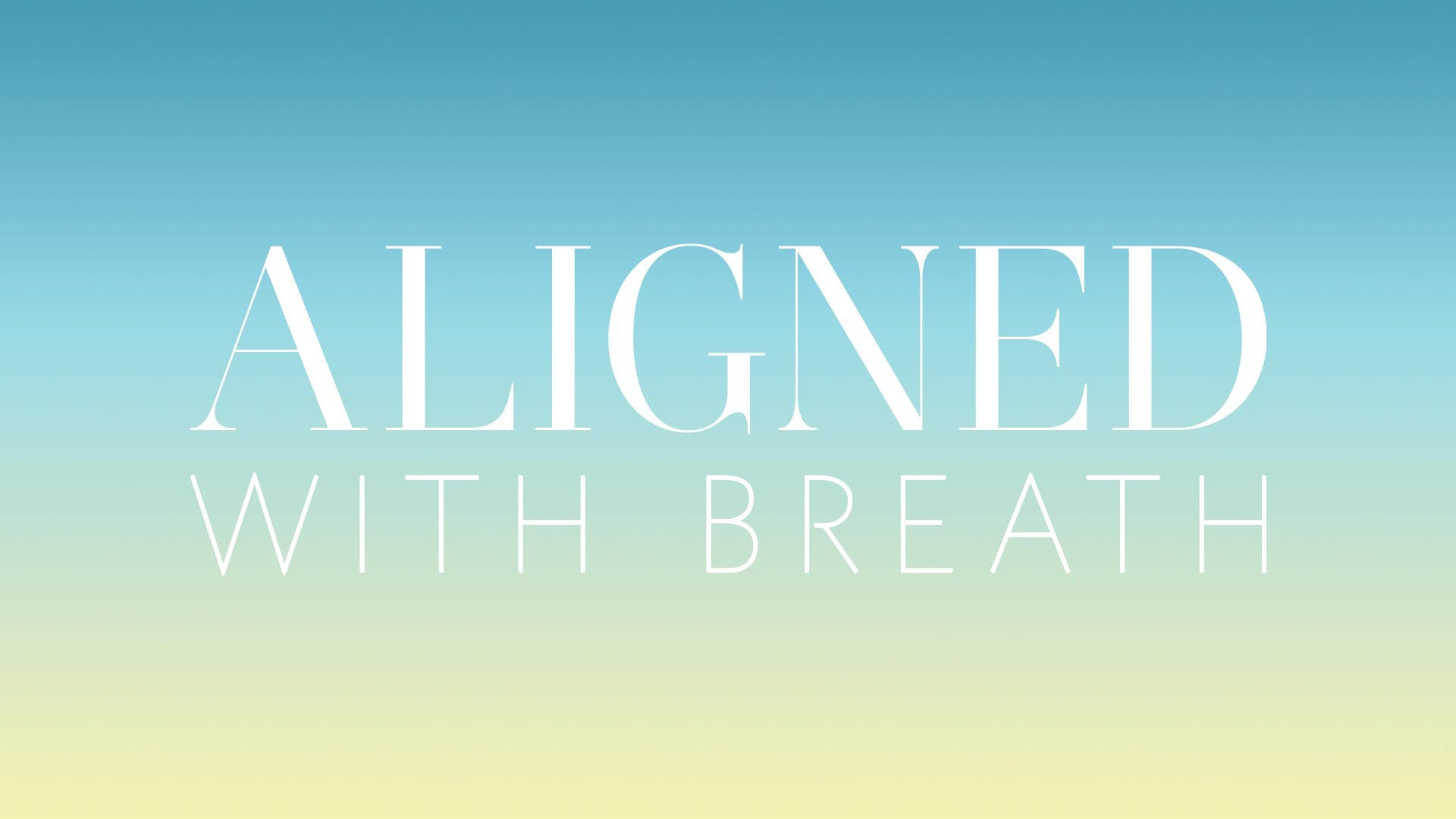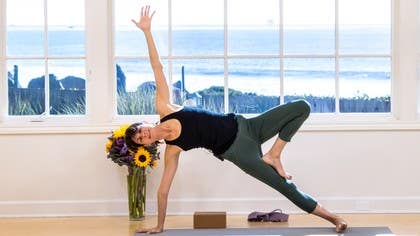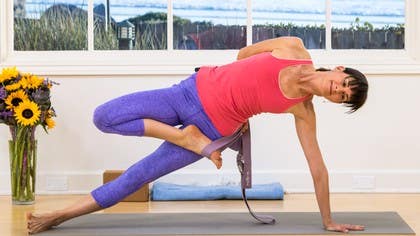Description
About This Video
Transcript
Read Full Transcript
(waves crashing) Hello and welcome to this breathing practice. We're going to take the blankets and create a little support for the heart and the lungs. Open a blanket, fold it a third over and then the end of it, just tuck it under so it's a little accordion style. And do that with two blankets, if you have two blankets, and it's fine to just stack two pillows or you know fold one blanket, just some kind of a, what we're doing is essentially creating kind of a mini bolster by stacking two folded blankets. And then the third blanket will just be folded in half for the head.
You do want to have your head a little bit higher than the rest of the body. So you're gonna put your props down. And this is gonna be my pillow, and then I'm going to sit just a little bit in front of the folded side. Notice I have the folded side where my pelvis is gonna be. The fringy side is over there.
So I'm gonna sit down, a couple inches in front and I'm gonna lengthen my legs and let them start out together and energized at the beginning. And then bring your hands behind you, lift your pelvis up a little, lengthen through your low back and then when you lie down, have the edge of the blankets hit more or less like beneath where your navel is. And then come back, the head blanket is going to support underneath the head and the neck, not the shoulders, but the head and the neck. And then I like to use my hands actually and kind of pull my shoulderblades down, use my thumbs to drag it down. You can also just kind of walk your shoulderblades down.
And the arms can rest out to the side, equidistantly spaced from your body, and attempt to have the same knuckle resting on the ground. And then you might need to relengthen through your tailbone, through your lower back, and then let your legs release. It's okay to let your legs go a little bit wider, but not too much wider for this because sometimes if they go too wide the energy gets too far away. Want to create a little sense of container in your body. The more I've done Pranayama in my life, the more gentle it's become.
And when my breathing practice is more gentle, it helps me in my life much more than a fancy, harsh breathing practice. Just feel the blankets underneath your spine. And invite the spine and the muscles that surround your spine to relax and release into those blankets. Let your head release completely into the pillow or the blanket that's beneath it. And then because the spine is supported, feel the legs are gonna drop down from the support of the spine.
Allow both of your legs to really release completely all the muscles softening their hold on the bones so that the bones can find gravity. And then from your heart center, invite softness into both shoulders, upper arms, elbows, forearms. Into your wrists and hands and every finger soft. Notice your hands, empty. And then relax the skin across your forehead.
Release the band of your eyebrows right to the flesh of your temples. Release the circular muscles that go around your eyes kind of like a raccoon's mask. Let those muscles soften. Relax the diagonal muscles of the cheeks and let your bottom jaw release from the top jaw. Invite a deep softness from your outer ear into your inner ears.
And then draw your attention to your breath and just notice how you're breathing now. There's absolutely no right way to be breathing, just see what's going on for you now. And then begin to let the breath deepen. And much like blowing up a balloon, the air comes in and then the balloon responds to the shape of the oxygen. Notice how your body responds to a slightly deeper breath.
Where does space come? Space comes with the inhalations and then as you exhale, how much can you freely release the breath as the body softens? Remember to be very gentle with your breath. And now let the next few breaths, they're going to be a little shallower than the ones you were probably just taking. Let the next few breaths just exist right in the low part of the belly, right around the navel, maybe down towards the pubic bone.
If you want to put a hand onto your low belly to feel that, you're welcome to do so. When you inhale, you consciously draw just some breath into the low belly. When you exhale, you can feel the skin soften to the muscles, the muscles down towards the low back and the organs as well. And the next little series of breaths that we're going to take is going to be a little bit deeper, and coming into the side seams of the body, so right around the breast, chest area inhale into the width of the ribs. Feeling the breath come right underneath your armpits.
As you exhale, those ribs soften down over the deflating lungs. Again a few soft, sweet breaths into your outer ribs, the side seams of your body expanding on the inhalation and softening on the exhalation. If at any point you find yourself starting to doze far away from this experience, take a few faster, more energetic breaths just to bring yourself back or even wiggle around a little bit and then come back. Even though it's okay to fall asleep, it's the different thing falling asleep versus Pranayama so try to stay awake. And then a couple of breaths we're going to take really full breaths and try to bring the breath all the way up to the level of your collarbones, the lungs actually come up and tuck up underneath your collarbones.
So just explore that feeling of expanding quite deeply. Letting the breath slide up underneath the collarbones. You might even be able to perceive the very top lobes of your lungs up there. Now take some regular breaths, just unconditioned breaths. I'm gonna begin viloma one, vi means against and loma means grain or hair.
So against the grain. We're taking a breath, but we're doing something a little unsmooth with it like against the grain, we're breaking it up into three parts. So I'll just describe it once and then we'll do it a few times. So take the first part of the breath into the belly, and then we'll take a little pause. Second part into the side ribs like we've been doing, pause, and the third part up into the collarbones upper chest.
So we've done all the component parts and now we're going to put it together with pauses in between. Remember not to force, not to harden. Please let it be gentle and soft. We'll start with an exhalation. And then inhale into the low belly, and pause.
Continue that breath up into the outer chest, side body. And pause. And then continue that breath all the way up filling the very top lobes of the lungs and pause. And then slow, smooth exhalation dissolving all the breath out. When you get to the bottom of that exhale, take a few unconditioned breaths just letting the body do as it wishes, but when we start again we start from a satya or a balanced place.
Exhale the breath out. Inhale belly, pause. Side seams of the body, pause. Up into the upper chest. Pause.
Slow exhalation. You're welcome to do this more quickly than I'm doing it or slower. And one note about the pauses. They're not like a (gasps) like a holding breath like maybe you, you do when you're I don't know, when I go through a tunnel sometimes I hold my breath and it's like (gasps) like a kid holds their breath. It's more of a spacious pause, meeting stillness.
A quiet openness versus any grip. Exhale completely. Inhale belly. Pause. Side body.
Pause. Top of the breath. Make sure your shoulders and facial muscles stay soft, pause. You can hold it as long as it feels okay. When you're ready, slow exhalation.
One more. Exhale. Inhale. Pause. Inhale.
Pause. Inhale. Pause. If it feels appropriate, you might want to do a little bit more inhalation coming into a dark corner of your lungs. When you're ready, you release the breath.
Let it go with freedom. Bring your hands onto your body. I often think about Buddhists who I see often calling the body the precious human body. Have a moment of gratitude for the gift of breath. And let your knees bend.
Take your time, you're going to roll off of your props and just rest on your side for a moment and after being in that slight slight backbend, just let your spine round in a little fetal curve. And then press into your hands, and make your way up. Thank you very much for joining me, namaste.
Aligned With Breath
Comments
You need to be a subscriber to post a comment.
Please Log In or Create an Account to start your free trial.









